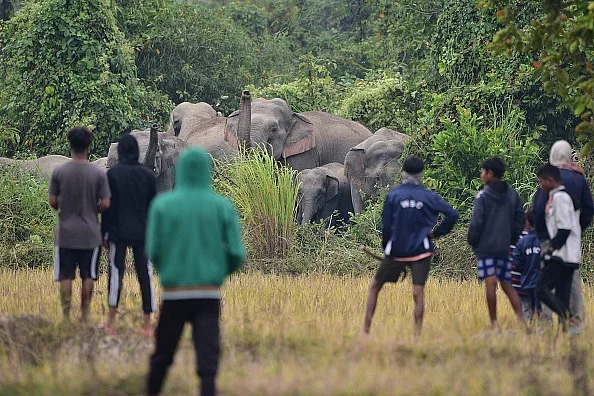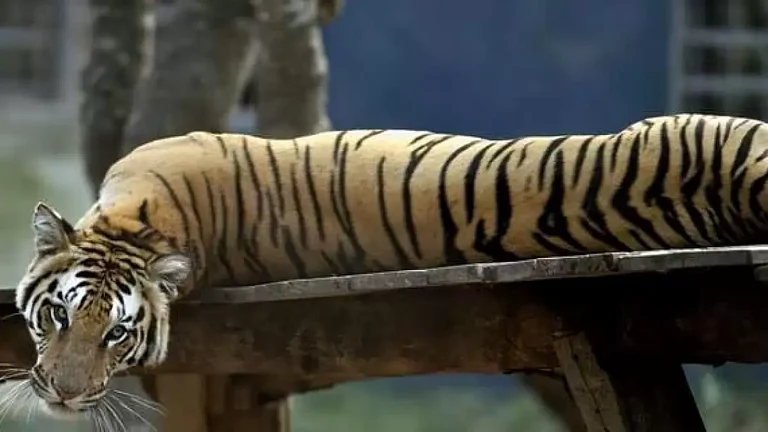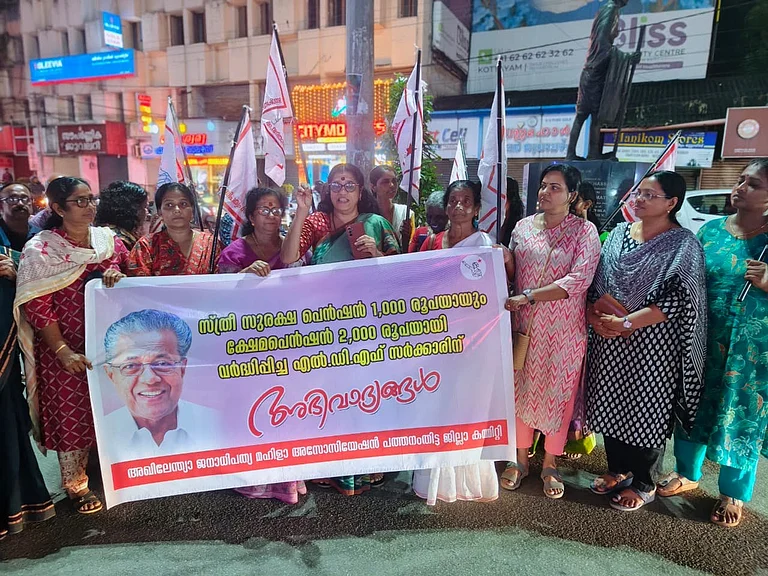The Wayanad district in Kerala is surrounded by thick forests of the Western Ghats, but the lives of people living close to these forests are full of struggles. Frequent attacks by wild animals are common, leading to damage to crops, vehicles and properties. In some cases, these animals attack livestock and humans, causing them injuries. Instances of loss of life, too, have been reported.
In February 2024, elephants killed three in the district— Lakshmanan, a tribal community member from Tholppetty; Ajeesh, a Mananthavadyresident; and Paul, a watcher from Kuruva Island. Such incidents have angered the public and created panic situations in the villages bordering the forests. These villagers have now become hostile towards the forest department and instances of protests against the administration are common; the significant one was in December 2023 after a tiger killed a young man named Prajeesh at Moodankolli, Poothady Panchayat.
The forest department is working full-time but is struggling to mitigate this conflict. They feel pressured due to demands of people to resolve these issues at the earliest. Incidentally, the recent attempts to capture elephants named Thanneer Kompan (the drugged elephant later died) and Belur Makhna, and the tiger that killed Prajeesh were unsuccessful. People are now feeling helpless and hopeless. The forest department and other government agencies must come up with a comprehensive plan to handle conflict situations whenever there is an attack on the human population and to ensure that wild animals do not venture into the thickly populated areas so that such violent attacks can be prevented.
As a result of increasing wildlife attacks on villagers, the state government feels that a collaborative effort between people, local self-government bodies, and the forest department is necessary to address this issue at the panchayat/municipality level.
An order to form Jana Jagratha Samithi (People’s Vigilance Committee) was issued in February 2017. These committees are expected to work as the public face of the Forest Department with the intention of making the conflict mitigation process more inclusive and collaborative in areas where such conflicts occur frequently.
This article investigates how far the JSS can act as an active agency in handling and transforming the human-wildlife conflict and tries to examine different approaches and a range of ways by which human-wildlife conflict could be addressed by the JSS in five local self-government bodies, which include Thirunelly, Noolppuzha, Poothady, Pulpally Panchayats and Sulthan Bathery municipality. All are within the boundary of the Wayanad Wildlife Sanctuary.
Visiting the Conflict-affected Villages and Victims
The writer first went to meet the relatives of Prajeeshin Poothady Panchayat on the 16th day of his posthumous ceremonies. Narrating what transpired that day, Majeesh said: “At around 12 pm, he went to the forest fringes to collect grass for their cattle. He did not arrive for lunch, so a search was conducted. I saw the jeep parked on the side of the road where he used to go regularly. I called him out loudly. When he didn't answer, I went into the field and started searching for him. That’s when I found his half-eaten body in the weeds.”
Soon after this incident, another tiger attacked and killed a cow that was tied in the cowshed in the neighboring village of the same Panchayat. It was an irreparable loss for Santhosh and Sunitha, who supported their family by raising cattle and farming. Talking about that day, Santhosh said: “On the night of December 17, Sunday, I stepped out after hearing a strange noise. I noticed that one of the cows in the cowshed was missing. The second cow was screaming in fear. When I looked near the cowshed, I saw a tiger holding our cow and it seemed dead already. I ran into the home and shut the door. However, the tiger became frightened after hearing our screaming and it left the place. We immediately contacted the forest officers. They came; even then, there was no attempt to capture the tiger immediately on that day. But on the next day, the tiger returned to the same location, and we became extremely frightened”.
The house is small with just one or two rooms, and the toilet is outside near the cowshed. “My father-in-law is visually impaired, and he is afraid to go out even in the day now. I also feel scared while working in the kitchen. Our sons are too scared to go to school. After the incident, the younger one got fever and was bedridden for a week, "his wife Sunitha added.
On December 23, 2023, a tiger killed a calf tied in a cowshed near Surendran's home in the same Panchayath. “Half of the calf was eaten. The forest officials arrived the same day. When I asked them to stay there to catch the tiger, they could not do that due to legal hurdles. I kept the rest of the dead cow there thinking that the tiger would come the next day,” says Surendran.
The forest department had installed a camera that day. “The next day the tiger came. It was there for almost two hours. If a net had been laid the day before, the tiger could have been captured. After eating the rest of the calf's meat, the tiger left. The forest department set up a trap the next day, but the tiger did not show up,” he added.
The villagers of Poothady and other local self-government bodies had similar complaints. They said that they were denied initiating resolution efforts with immediate effect. It is also clear from this that the JSS is struggling to address, handle, and reduce the human-wildlife conflict.
How Does the Committee Works?
The JSS meetings are held under the chairmanship of the Panchayat President/Municipality Chairperson, and the Range Officer or Deputy Range Officer in charge of the forest area under the jurisdiction of the Gram Panchayat or Municipality act as conveners.
The structure of the Committees includes representatives from Panchayats, an agriculture officer, a veterinary surgeon, a village officer, and members of the forest protection committee/eco development committee, beat forest officers from the forest department and three farmers who serve as local community representatives. Their major responsibilities include, (a) informing the forest department about the most suitable preventive measures for the area, (b) helping the forest officers to assess any damages happening to the existing defenses and seek necessary actions (c) helping forest department immediately in case of wildlife attack, (d) creating awareness among farmers about farming practices that do not attract wildlife, (e) providing SMS alerts in case of wildlife presence/attack, etc.
Possibilities and Challenges of the JJS
Most people opined that the committee has both potentialities and limitations in dealing with human-wildlife conflict. The strengths of the JSS include paving the way for community participation, creating forum for discussing different local issues, providing decision-making power and capacity building, sharing responsibilities and duties, establishing a transparent platform for airing different opinions, empowering grassroots democracy, and improving self-reliance.
On the other hand, the limitations and challenges include the lack of financial resources, support from state and central governments, powers in the implementation process and people participation in the implementation of schemes and missions, domineering attitude of the forest department, inadequate policy on interventions, the inefficiency of the existing strategies, lack of monitoring and evaluation, lack of proper strategic planning, etc.
It has been noticed that in addition to discussing wildlife conflicts in the area, the meeting also included the agenda about the assessment of the conflict mitigation activities currently being carried out under the supervision of the Forest Department. Most of the debates focused on evaluating the efficacy of fences, trenches, stonewalls, and other conflict mitigation strategies. They also discussed the unscientific afforestation process of planting teak, acacia, and eucalyptus which destroyed the natural habitats of the forest and resulted in drought and a scarcity of resources for wildlife. In most of the meetings, it was observed that invasive plants should be uprooted, and natural afforestation should be done in such places, and immediate action must be taken to accomplish this.
“If people are given jobs and wages for all of the activities required to prevent wildlife attacks, people's attitudes towards the forest department will change, and people should also try to reduce human-wildlife conflict,” one of the Eco Development Committee members stated. V Baby, a representative from Thirunelly Panchayath, shared: “There is a perception that the forest department is solely responsible for all conflicts because it conducts all existing activities solely. However, with collective action, such feelings will change, and people will have a sense of participation and responsibility.”
The main concern raised by the representatives at the committee meeting was the lack of funds to panchayat for implementing mitigation strategies which may cost crores of rupees. “Currently, the central and state governments have to allocate more funds to at least the panchayats where the conflict is severe,” remarked Mini Prakashan from Poothady Panchayat President.
Johny Kanaparampil, a VSS (Vana Samrakshana Samithi) member from Poothady, indicated that attempts have been made in various meetings to speed up the disbursement of compensation to the victims who have incurred damage as a result of wildlife attacks. He says: "The compensation for agricultural and livestock damage, as well as to human loss, is regularly delayed. The current amount seems insufficient to cover the losses. This is why many people feel upset and even angry towards the forest department and are hostile to wildlife. Everything is discussed in committees, but no actions have been taken so far”.
The major criticism is that people and local self-governing institutions are excluded from the stages of implementing conflict mitigation strategies discussed in the meetings. Currently, local governments have no power to take actions in resolving human-wildlife conflict.
“There are people in this region of the forest who have practical suggestions and solutions for the promotion of friendly human-animal relations. However, the members of the present committee lack the structural power to properly implement the suggestions based on their traditional knowledge, experiences, and opinions. Now, no decision could be made by the elected members of Panchayats without the permission of the Forest Department,” said Thirunelly Panchayat representative.
According to Emmanuel, a member of the JJS, “The current laws and policies are insufficient to provide and grant powers and directions to a participatory system such as the JJS. Even while analysing the functions and activities of the JJS, it is obvious that the forest department is unable to propose tangible remedies or design for the general public who are affected by wildlife attacks.”
Conclusion
It has been seen that the JJS is a platform to collectively discuss local issues and it is being well received and welcomed by the members of the JJS. Even though now people do not get any role beyond participation at the initial discussion, the full responsibility and authority for the implementation of the respective decisions is vested in the Forest Department. The expectations of the people are that local government institutions must have equal authority and power like the forest department in conflict mitigation initiatives and processes. It is felt that the mitigation work will be more effective when the structure and the powers of the committee can be expanded with more community participation, including tribal heads, farmers, women, youth, and children. And it also suggeststhat the participation of NGOs, political parties and experts from the field such as revenue officers, agricultural officers, village officers, veterinary surgeons, and researchers working in the respective areas will strengthen the mitigation efforts.
It is concluded that the best conflict mitigation is possible when a system is evolved with the inclusion and participation of local people of a village in the formulation and implementation of viable solutions to a problem they face in their locality.It is strongly believed and acknowledged that the human-wildlife conflict can only be addressed by improving grassroot democracy and by ensuring participatory governance.
To ensure that the Government of Kerala and the Forest and Wildlife Department have to make changes in the current structure of the JSS as per the order given on February 2017 and recommend the authorities to issue a new order by creating avenues for the inclusion of more members for participatory mitigation works and giving more powers to Local Self Government Institution in the planning and implementation process as well.
Ramseena P.P is a Research Scholar at Dept. of Gandhian Thought and Peace Science, Gandhigram Rural Institute (Deemed to be University), Tamil Nadu
(Views expressed are personal)










.jpg?auto=format%2Ccompress&fit=max&format=webp&w=768&dpr=1.0)










